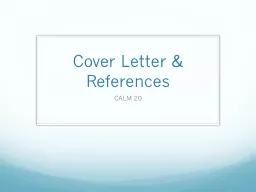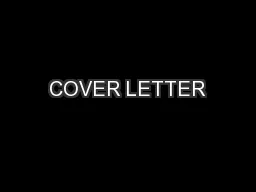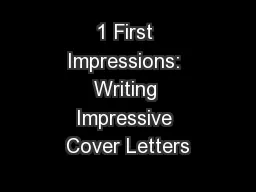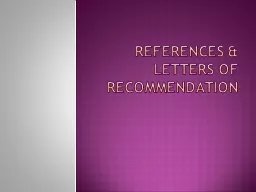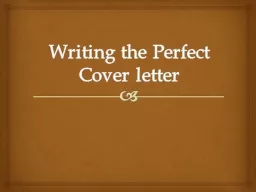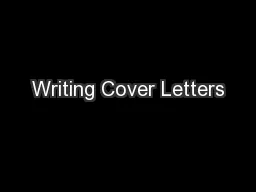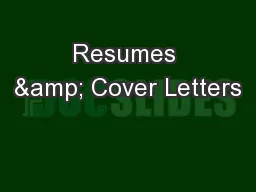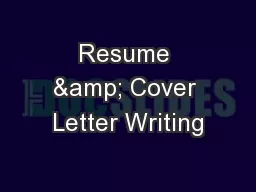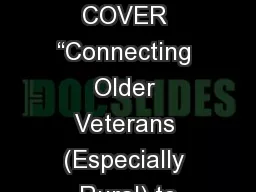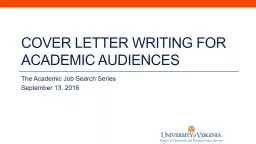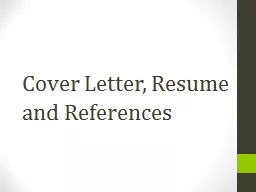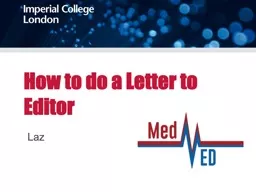PPT-Cover Letter & References
Author : kittie-lecroy | Published Date : 2016-08-01
CALM 20 What is a Cover Letter A cover letter is a formal letter that accompanies your résumé Use it to introduce yourself to potential employers and to convince
Presentation Embed Code
Download Presentation
Download Presentation The PPT/PDF document "Cover Letter & References" is the property of its rightful owner. Permission is granted to download and print the materials on this website for personal, non-commercial use only, and to display it on your personal computer provided you do not modify the materials and that you retain all copyright notices contained in the materials. By downloading content from our website, you accept the terms of this agreement.
Cover Letter & References: Transcript
CALM 20 What is a Cover Letter A cover letter is a formal letter that accompanies your résumé Use it to introduce yourself to potential employers and to convince them that youre the right person for the job. format First Name Last Name Title Company Name Street Address City State Zip Dear Ms Mr Dr or Hiring Manager or To Whom It May Concern In the FIRST PARAGRAPH tell how you heard about the job and if appropriate name the person who told you about it M The Basics. Jobs for Montana's Graduates B9L1PP1. A cover letter is a three to four paragraph business communication that usually accompanies a job applicant’s resume. . The . purpose of the cover letter is to interest the employer enough to want to get to know the applicant better through an . Lisa M. Patterson. Associate Dean for Career Services. 608 O’Brian Hall. 716-645-2056. lpatter@buffalo.edu. 2. What is a Cover Letter?. A Business Letter. use formal language, . format. Your first contact with a potential employer. Whom to ask for reference and letters of recommendation?. They must:. Know you well (e.g., taken for multiple classes, done a directed study with, talk outside of class). Have known you for a prolonged period of time. What is a cover letter?. A cover letter is a . formal letter . that accompanies your . resume. . It is used to . introduce yourself to potential . employers . and to convince them that you’re the right person for the job.. 9/4/2015. Announcements. Feeder . 3 . (Cover letter) Draft due . Wednesday 9/9). Final of Feeder 2.2 due . Friday 9/11). . . Interviews . will be on 9/22, 9/23, 9/28, 9/29. Sign up sheets available . Student Career Development. Business Administration 036. (740) 351-3027. Careers@shawnee.edu. . RESUME & COVER LETTER 101. Nikki Karabinis. Director. Student Career Development. Purpose. To get you an interview, NOT A JOB, by communicating your knowledge, skills and values.. What is a Resume?. A resume is a summary of your experiences and skills . relevant. to the field of work you are entering.. A resume is an accomplishment driven marketing tool for individuals seeking employment.. Community Or Veteran Eligible Resources” . Collaborative project between the Utah ADRC and VHA Office of Rural Health: . Building VA Partnerships to Better Serve Veterans . What we will cover today. Cover Letter Activity!. You will use the Cover Letter handout for this activity.. Your group will receive . TWO. scenarios. For each, you must craft a cover letter.. First, read the scenarios.. Decide. The Academic Job Search Series. September 13, 2016. Agenda. What is it?. Your introduction. Content. Peer Review. Tailoring your Cover Letter. Q & A. What is a Cover Letter?. A supplement to the CV that includes more detailed information about yourself. What is a resume?. 1-2 page summary of your high school education, activities, volunteer and paid work experience, and skills. You should add to and update it with your most recent achievements often.. Laz. What is a letter to editor?. A short communication regarding a topic that is of interest to the readership of the journal, usually in response to an original research article.. Key points to check . Always choosing the right covers for your brick kiln to protect the bricks from harsh weather. Raw bricks are readily harmed by moisture; thus, it is critical to cover them with a high-quality waterproof tarpaulin cover. Here is the best choice of Silpaulin Raw Bricks kiln cover which is manufacture of cross-laminated, multi-layered, UV stabilized. These brick kiln covers are completely waterproof, ensuring that the bricks are not harmed.
Download Document
Here is the link to download the presentation.
"Cover Letter & References"The content belongs to its owner. You may download and print it for personal use, without modification, and keep all copyright notices. By downloading, you agree to these terms.
Related Documents

